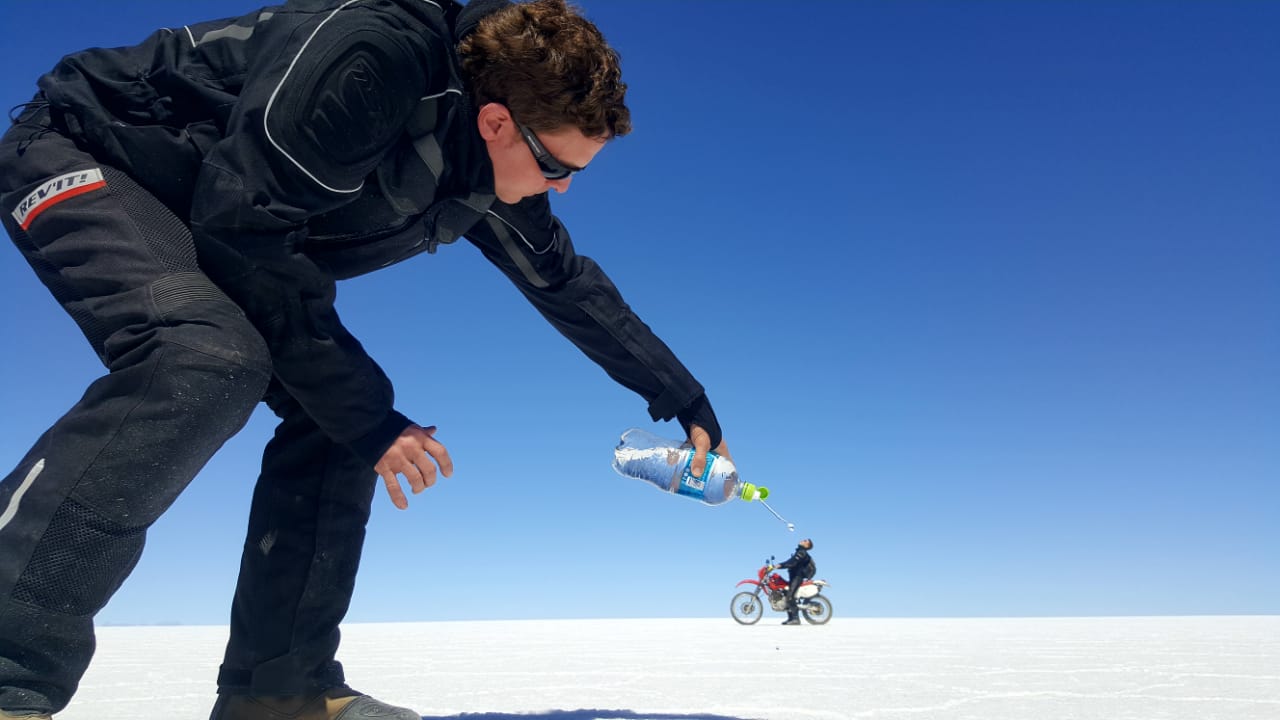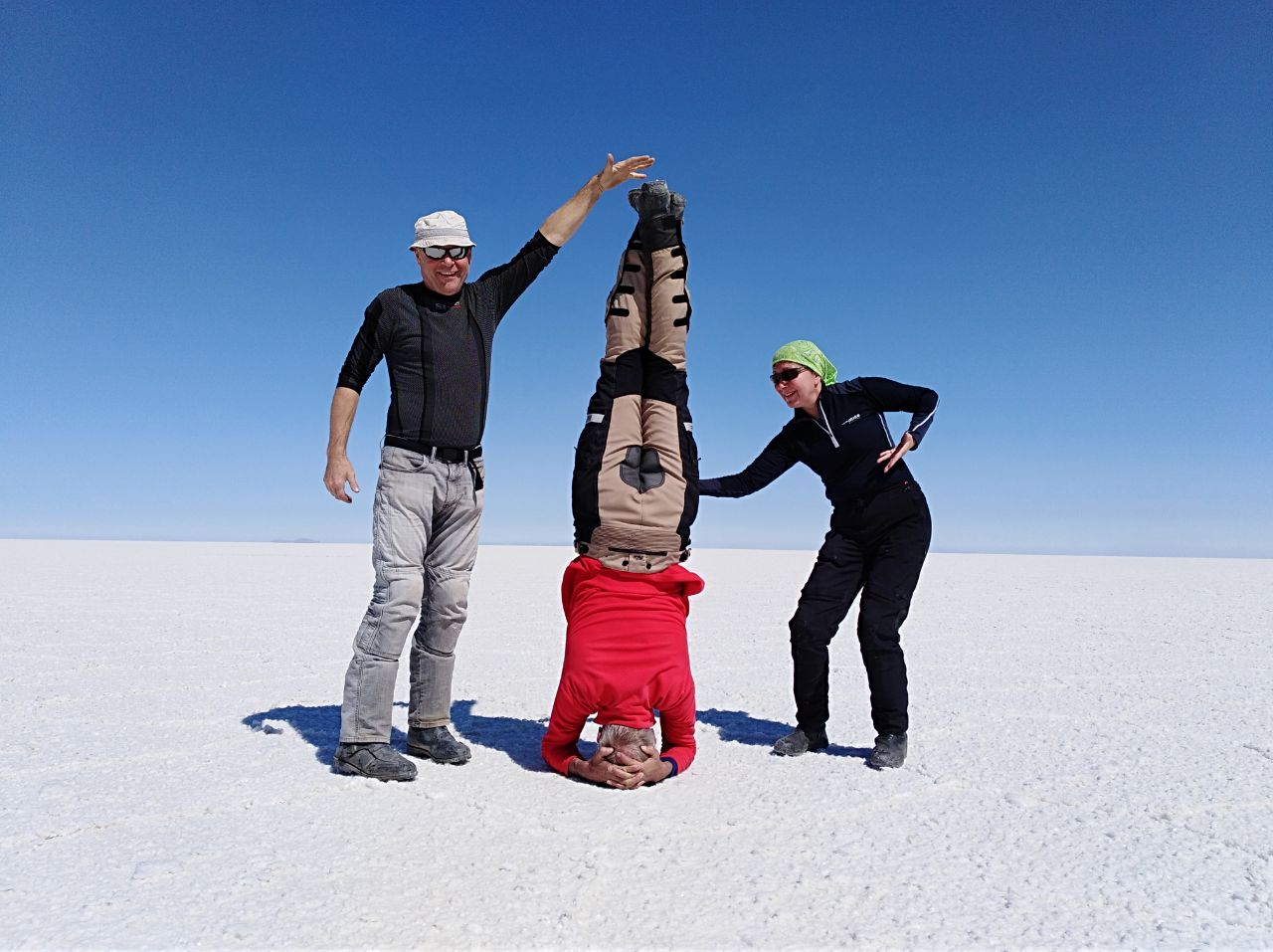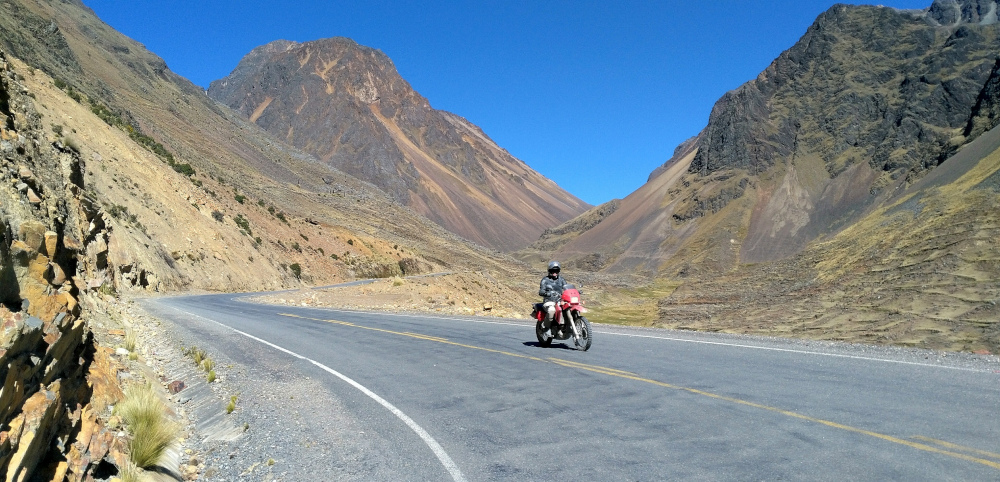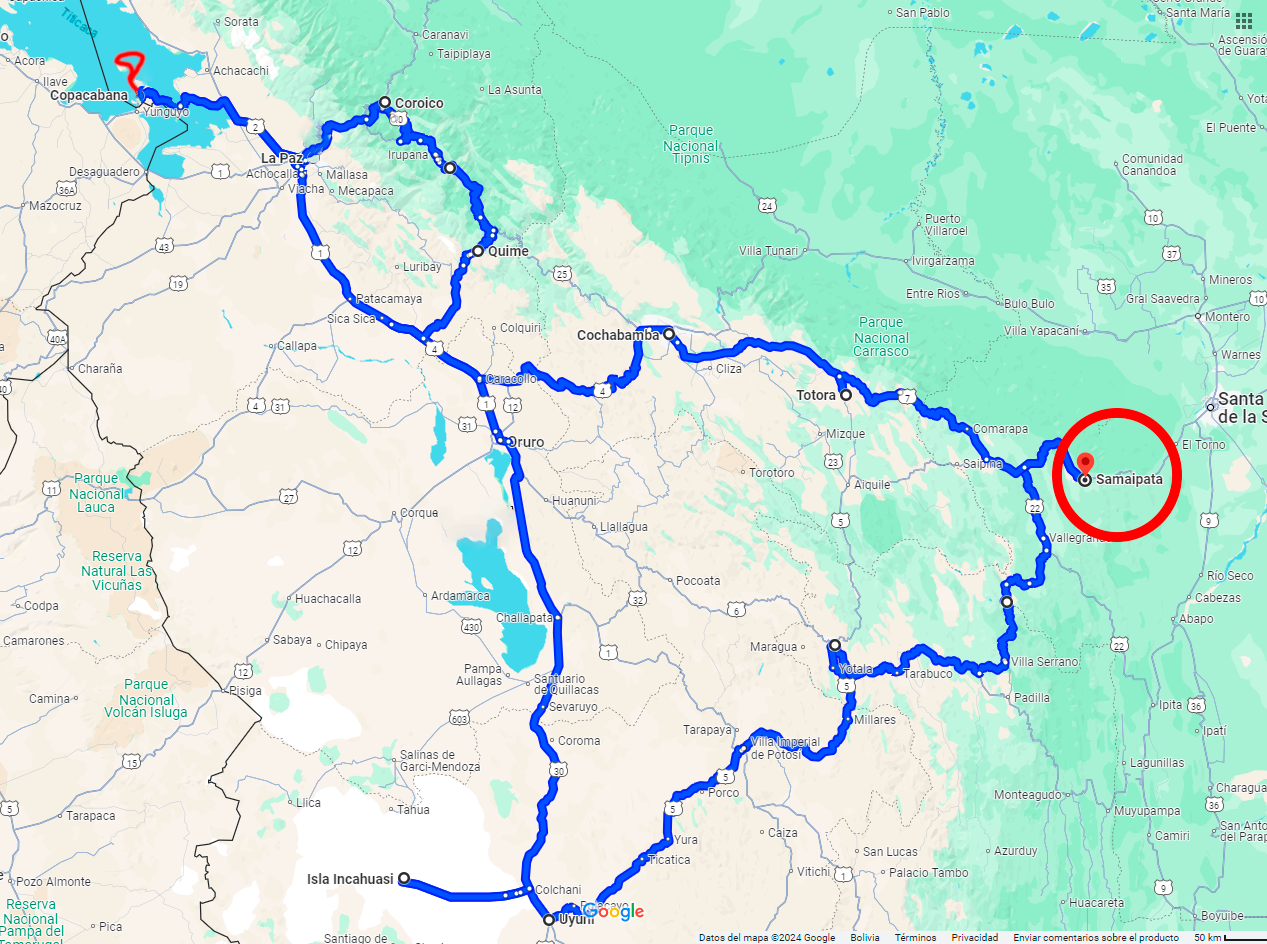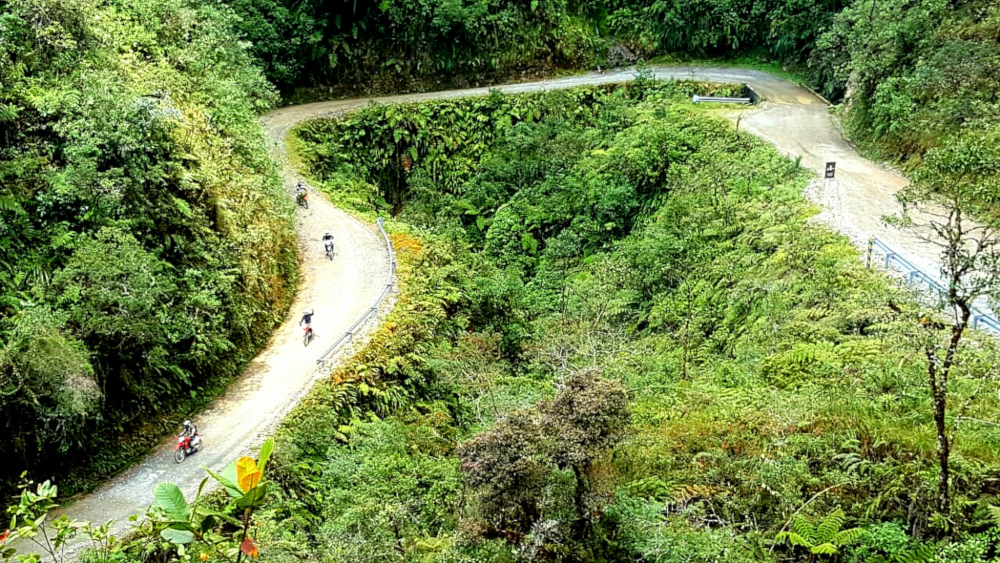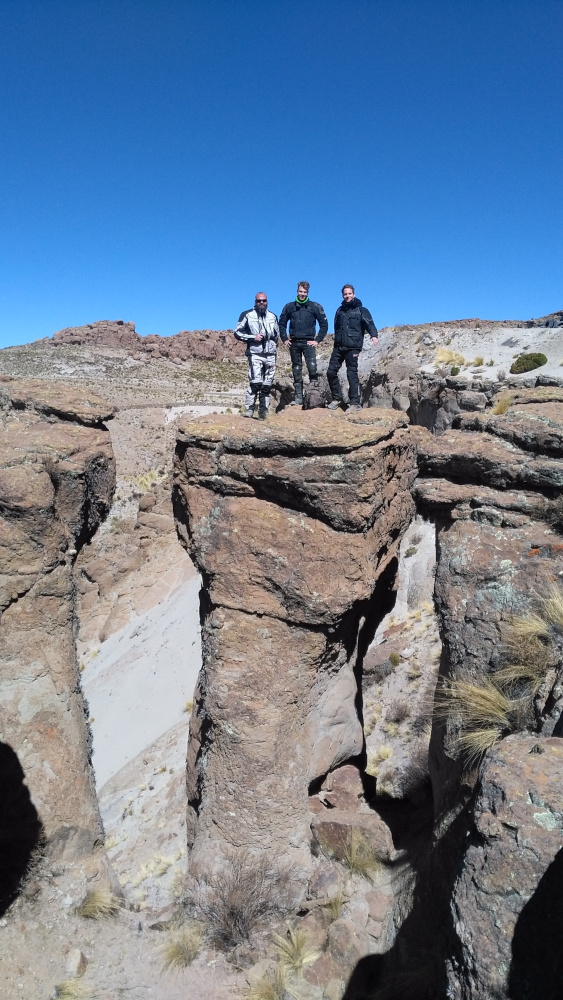Highlander 2
20 Day. Level: Medium, 2.970 km, 30% dirt-road Price info
For those who want to see all of Bolivia´s highlights and ride lots of dirt-road, but nothing too difficult for the average motorcyclist. Starting with the “Ruta del Ché” we make our way to the indigenous market of Tarabuco, following to the colonial Sucre, the capital of Bolivia. Continuing, we ascent to Potosí, the highest city in the world and the oldest operating silver mines in the world. This is followed by the “Salar de Uyuni”, the largest salt flat in the world, the train grave yard, the Dakar monument and Lake Titicaca, the highest navigable lake in the world. Including the most dangerous road in the world, the infamous “Death Road”, the coca leaves plantations, we reach the highest Christo statue in the world. Photographer get prepared for a 100 years’ time travel in Totora.
A tour filled with extremes, on a selection of the best motorcycle roads available.
Highest riding peak: 4.650m.
Day 7. To Uyuni (alt. 3.700 m), 205 km, 5% dirt-road Riding through incredible scenery we make a stop at a spectacular canyon. Along the road we look out for vicuñas (family of camelids), emus and thousands of lamas. We arrive at the small mining village of Pulacayo. Here we walk around the ancient railway station, past the mine entrance and we can climb the train wagons which are the very same ones the American outlaws Butch Cassidy and The Sundance Kid arrived in when they came to Bolivia 110 years ago. Next break is Uyuni where we visit the train grave yard, a fantastic collection of discarded railway machinery dating back to the 19th century. This includes at least a dozen steam locomotives. Perfect for photo shooting.
Day 8. Salar de Uyuni daytrip (alt. 3.700m), 195 km, 90% dirt salt-road The Salar de Uyuni is a dried up salt lake, with the size of a small country (11.000 km square). Since the largest salt lake of the world has, no references, what so ever and because there are only two colours in this world (blue sky and white salt), there is no perspective. Our brain will have a meltdown and we can take the weirdest crazy photos. On our way, we visit the cactus island “Inca Huasi”, the flags monument, the first salt hotel and… the Dakar monument.
Day 9. To Oruro (alt. 3.700 m), 320 km, 0% dirt-road In the morning we leave Uyuni behind us. On a nice place we make a snack stop. Passing scenic “altiplano” landscapes and several small villages, we make our way to Oruro, famous for its markets and grill restaurants. So “grill” will be treat in the evening. Arriving, close to Oruro we visit a ghost city. In Oruro we observe a strange phenomenon. More should not be divulged here!
Day 10. To Copacabana on Lake Titicaca (alt. 3.800 m), 360 km, 0% dirt-road
To avoid the chaotic traffic in the city of El Alto we leave Oruro early in the morning by the new built motorway. Conditional to our arrival time nearby El Alto, we evaluate to take a short cut towards Lake Titicaca. Crossing the crystal blue waters to the peninsula of famous Copacabana on a pontoon, we enjoy views of snowcapped mountains over the clear blue lake. Our hotel has a marvellous view of the lake. Guess what’s going on for dinner?
Day 11. Daytrip to the Island of the Sun and the Island of the Moon
Exchanging our bikes for a boat, we visit 2 legendary islands from the Inca times. On Island of the Sun we make a short hike with fantastic views of the snow-covered mountains that border Lake Titicaca. On Island of the Moon we visit the ruins of moon virgin’s temple.
Day 12. To La Paz (alt. 3.600 m), 145 km, 5% dirt-road In the morning we leave lake Titicaca behind, stop at the La Paz view point and arrive in La Paz, the defacto capital of Bolivia at noon. In the afternoon we start to a round trip over La Paz and El Alto by funicular, unique in the world. Actually there are 7 lines in service. Don´t worry: Made by Doppelmayr, Austria. It is possible to visit the witches market where we could buy anything ranging from magic potions and amulets to mummified llama embryos. In the evening we can witness the changing of the guards at the presidential palace.
Day 13. The Death Road to Coroico (alt. 4.650 to 1.750 m), 85 km, 70% dirt-road From La Paz we ride to Coroico on what was once officially the most dangerous road in the world. Plummeting down into the tropical Yungas region, the views are magnificent and if we keep our speed down, we have a very good chance to arrive safely in Coroico. For the really brave we finish today’s ride with a 500 m zip line adventure, siting or in spider position. From here only 45 minutes ride to the hotel´s pool.
Day 14. To Chulumani (alt. 1.700 m), 80 km, 100% dirt-road We leave Coroico and follow narrow unpaved mountain roads through the Yungas, well known for its coca leaves plantations. Passing small picturesque mountain villages and on the end, a very scenic real death road, we arrive in Chulumani around noon. Time to soak in the swimming pool, explore this bustling agronomic trade centre of the Yungas or just to relax.
Day 15. To Quime (alt. 3.030 m), 195 km, 100% dirt-road Again an entire day of narrow, unpaved roads following deep ravines, crossing rivers and passing tiny settlements. Late in the afternoon, the last hour before arriving, we ride on the edge of a small curvy gorge road with a splendid view. Quime is a small cradled mining town in between massive mountains. Our dinner and hotel are basic and very Bolivian.
Day 16. To Cochabamba (alt. 2.500 m), 315 km, 10% dirt-road After a Bolivian breakfast we leave Quime. At a traditional sanctuary we sacrifice cigarettes, alcohol and of course Coca leaves to the patron saint of the place. On curvy roads with amazing views we climb to 4.400 m altitude, before we descent to the valley of Cochabamba. On a nice place we make a snack stop and change our bike gear for warmer regions. After we have mastered the Cochabamba traffic, we rush straight to the plaza, from where we cuddled the bustle. At one plaza corner is the best us known coffee “cortado” café and for dinner we enjoy the best us known “Pique Macho”, a traditional dish.
Day 17. To Totora (alt. 2.800 m), 145 km, 0% dirt-road In the morning we visit the largest “Christo” sculpture of South America. With almost 40 m, quite a bit higher than the famous “Christo de Rio de Janeiro”. After this we leave the big city to have a fresh fish lunch and passing beautiful valleys. We make our way to Totora, a small colonial town in the mountains, where time stands still since 100 years. Paradise for photographers.
Day 18. To Samaipata (alt. 1.650 m), 265 km, 0% dirt-road This last day starts with riding through cloud forests and stop at spectacular view points. In the afternoon we arrive back in Samaipata, leave our bikes behind and hurry to jump into the hotel´s pool.
Day 19. To Santa Cruz Late in the morning, we set off for Santa Cruz where we can relax, hanging around the plaza and do some souvenir shopping. In the evening, we have a farewell dinner.
Day 20. To the airport Always a sad moment when we say goodbye. But who knows? You won´t be the first to come back for more…
Day 1. Airport pickup at Viru-Viru, Santa Cruz (alt. 400 m) We pick you up at the airport of Santa Cruz/ Bolivia from where we drive to the small town of Samaipata (120 km, 2,5 hours). There we check into a comfortable hotel and spend the rest of the day to relax and discover. If your flight arrives late, you need to spend the night in Santa Cruz. In that case the following day is considered as Day 1.
Day 2. Samaipata (alt. 1.650 m) We start with the briefing where we learn more about safety riding, our route, the local traffic rules and about each other. To get used to our bike, we go for a ride to the archeological site of “El Fuerte”. Classified World Heritage by UNESCO, it is an old Inca town build around the, much older, largest stone sculpture in the Americas. For some people, it is an ancient Alien landing field!
Day 3. To La Higuera (alt. 1.900 m), 175 km, 50% dirt-road Leaving early in the morning, we stop in Vallegrande to visit the hospital´s laundry building, where revolutionary hero Ernesto Ché Guevara´s lifeless body was first presented to the world in 1967. After lunch, we continue our ride towards the tiny mountain village of La Higuera, the place where the Ché was captured and executed. On the road it’s possible to observe condors, the world biggest bird. Before arriving at the hotel in La Higuera we have the option to detour on a special ride to a fantastic view. In the evening around the campfire in the courtyard of our hotel, we listen to Don Juan’s experiences from the time of the guerrilla war.
Day 4. To Villa Serrano (alt. 2.100 m), 120 km, 100% dirt-road After visiting the historic school building where Ché Guevara was executed and the related sites, we leave towards Villa Serrano. On the suspension bridge over the Rio Grande we have a snack stop and if the conditions are good and the water level is safe, we can go for a swim. In the afternoon we arrive in Villa Serrano, Bolivia’s capital of charango music. It´s a kind of a small, double 5 strings guitar, very difficult to play.
Day 5. To Sucre (alt. 2.700 m), 190 km, 15% dirt-road We leave Villa Serrano early in the morning so we can visit the Tarabuco Sunday market. This is the only place in Bolivia where we can take photos of traditionally dressed indigenous people without them turning away. After lunch we continue to Sucre the capital of Bolivia. The rest of the afternoon and evening is for exploring this beautiful colonial city. The entire city center is painted white and is classified as a World Heritage site by UNESCO.
Day 6. To Potosí (alt. 4.100 m), 155 km, 0% dirt-road We leave Sucre early in the morning. On smooth tarmac we start to climb towards the altiplano (highland planes). We stop and visit a strange monumental bridge. Then onwards to the mining city of Potosí which sits at 4.100 m altitude, making it the highest city in the world and also classified Word Heritage by UNESCO. During the ascent, the guides will give us instructions about to deal with altitude sickness. In the afternoon, we visit the miner’s market where we can buy anything, ranging from coca leaves and dynamite. Then we continue to the mines where we will get “geared up” and descend into the belly of “Pajcha Mama” (mother earth) to visit the 500 year old but still operational silver mine. This is not suitable for those who don’t like small spaces or suffer from claustrophobia.
The best way to explore Bolivia by motorcycle
Need more information?

